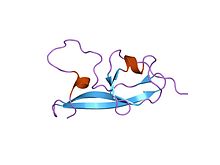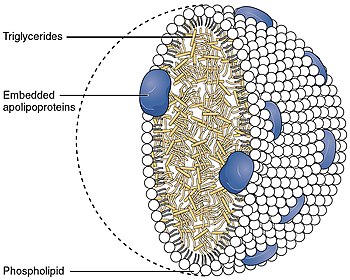Apolipoprotein H
β2-glycoprotein 1, also known as beta-2 glycoprotein 1 and Apolipoprotein H (Apo-H), is a 38 kDa multifunctional plasma protein that in humans is encoded by the APOH gene.[5] One of its functions is to bind cardiolipin. When bound, the structure of cardiolipin and β2-GP1 both undergo large changes in structure.[6] Within the structure of Apo-H is a stretch of positively charged amino acids (protein sequence positions 282-287), Lys-Asn-Lys-Glu-Lys-Lys, are involved in phospholipid binding (see image on right).[7]
β2-GP1 has a complex involvement in
Although previously referred to as apolipoprotein H, it is not present in appreciable quantities in the lipoprotein fractions, so ApoH is therefore thought to be a misnomer.[9]
Inhibitory activities
β2-GP1 appears to completely inhibit serotonin release by the platelets[10] and prevents subsequent waves of the ADP-induced aggregation. The activity of β2-GP1 appears to involve the binding of agglutinating, negatively charged compounds, and inhibits agglutination by the contact activation of the intrinsic blood coagulation pathway.[11] β2-GP1 causes a reduction of the prothrombinase binding sites on platelets and reduces the activation caused by collagen when thrombin is present at physiological serum concentrations of β2-GP1 suggesting a regulatory role of β2-GP1 in coagulation.[12]
β2-GP1 also inhibits the generation of
In addition, β2-GP1 inhibits the activation of protein C blocking its activity on phosphatidylserine:phosphatidylcholine vesicles[15] however once protein C is activated, Apo-H fails to inhibit activity. Since protein C is involved in factor Va degradation Apo-H indirectly inhibits the degradation of factor Va.[16] This inhibitory activity is diminished by adding phospholipids suggesting the Apo-H inhibition of protein C is phospholipid competitive.[17] This indicates that under certain conditions Apo-H takes on procoagulation properties.
Pathology
Anti-β2-GP1 antibodies are found in both infectious and some systemic autoimmune diseases (eg.
Sushi 2 protein domain
| Sushi_2 | |||||||||
|---|---|---|---|---|---|---|---|---|---|
 NMR structure of the fifth domain of human beta-2 glycoprotein 1 | |||||||||
| Identifiers | |||||||||
| Symbol | Sushi_2 | ||||||||
| Pfam | PF09014 | ||||||||
| InterPro | IPR015104 | ||||||||
| |||||||||
In
Structure
This protein domain is composed of four well-defined anti-parallel beta-strands and two short alpha-helices, as well as a long highly flexible
Function
Its exact function remains to be fully elucidated; however it is known to play an important role in the
References
- ^ a b c GRCh38: Ensembl release 89: ENSG00000091583 – Ensembl, May 2017
- ^ a b c GRCm38: Ensembl release 89: ENSMUSG00000000049 – Ensembl, May 2017
- ^ "Human PubMed Reference:". National Center for Biotechnology Information, U.S. National Library of Medicine.
- ^ "Mouse PubMed Reference:". National Center for Biotechnology Information, U.S. National Library of Medicine.
- ^ "APOH - Beta-2-glycoprotein 1 precursor - Homo sapiens (Human) - APOH gene & protein". UniProt. Retrieved 5 May 2019.
- PMID 7586693.
- S2CID 12529388.
- S2CID 23669362.
- S2CID 43329586.
- PMID 3827975.
- PMID 4052628.
- PMID 3768409.
- S2CID 35371017.
- S2CID 89295513.
- PMID 8227406.
- S2CID 42539225.
- S2CID 34123144.
- PMID 12082318.
- PMID 2349221.
- S2CID 35296154.
- ^ PMID 15522884.
- ^ PMID 11124037.
External links
- Apolipoprotein+H at the U.S. National Library of Medicine Medical Subject Headings (MeSH)
- Apolipoprotein H and Applied Research
- Human APOH genome location and APOH gene details page in the UCSC Genome Browser.
- PDBe-KB provides an overview of all the structure information available in the PDB for Human Apolipoprotein H (B2G1)

